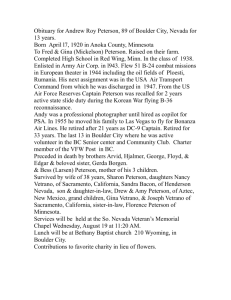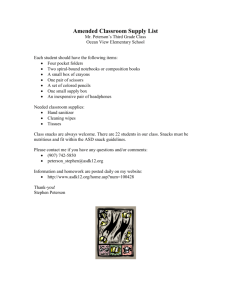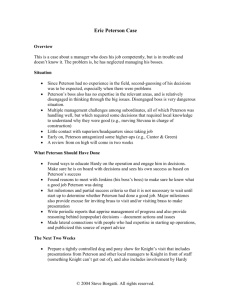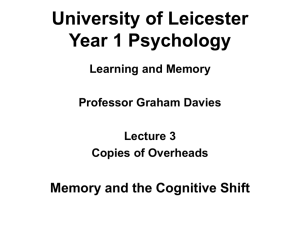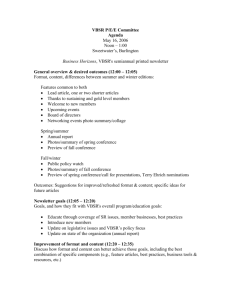James Christian Peterson - 2nd child of Lars and Elsie
advertisement
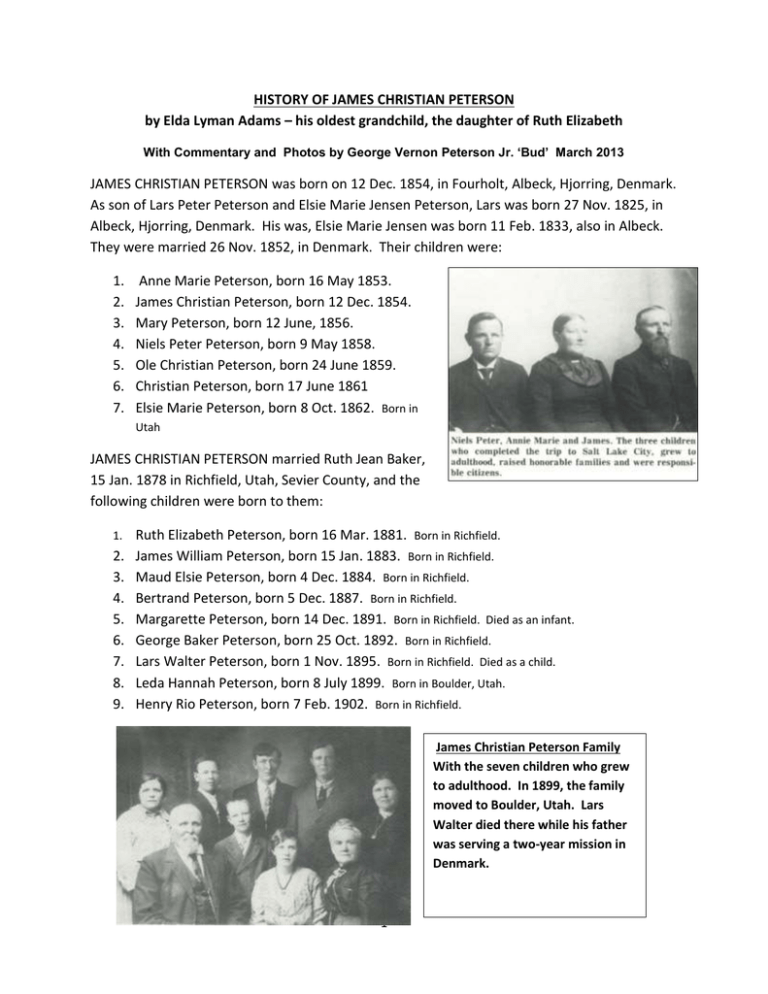
HISTORY OF JAMES CHRISTIAN PETERSON by Elda Lyman Adams – his oldest grandchild, the daughter of Ruth Elizabeth With Commentary and Photos by George Vernon Peterson Jr. ‘Bud’ March 2013 JAMES CHRISTIAN PETERSON was born on 12 Dec. 1854, in Fourholt, Albeck, Hjorring, Denmark. As son of Lars Peter Peterson and Elsie Marie Jensen Peterson, Lars was born 27 Nov. 1825, in Albeck, Hjorring, Denmark. His was, Elsie Marie Jensen was born 11 Feb. 1833, also in Albeck. They were married 26 Nov. 1852, in Denmark. Their children were: 1. 2. 3. 4. 5. 6. 7. Anne Marie Peterson, born 16 May 1853. James Christian Peterson, born 12 Dec. 1854. Mary Peterson, born 12 June, 1856. Niels Peter Peterson, born 9 May 1858. Ole Christian Peterson, born 24 June 1859. Christian Peterson, born 17 June 1861 Elsie Marie Peterson, born 8 Oct. 1862. Born in Utah JAMES CHRISTIAN PETERSON married Ruth Jean Baker, 15 Jan. 1878 in Richfield, Utah, Sevier County, and the following children were born to them: 1. 2. 3. 4. 5. 6. 7. 8. 9. Ruth Elizabeth Peterson, born 16 Mar. 1881. Born in Richfield. James William Peterson, born 15 Jan. 1883. Born in Richfield. Maud Elsie Peterson, born 4 Dec. 1884. Born in Richfield. Bertrand Peterson, born 5 Dec. 1887. Born in Richfield. Margarette Peterson, born 14 Dec. 1891. Born in Richfield. Died as an infant. George Baker Peterson, born 25 Oct. 1892. Born in Richfield. Lars Walter Peterson, born 1 Nov. 1895. Born in Richfield. Died as a child. Leda Hannah Peterson, born 8 July 1899. Born in Boulder, Utah. Henry Rio Peterson, born 7 Feb. 1902. Born in Richfield. James Christian Peterson Family With the seven children who grew to adulthood. In 1899, the family moved to Boulder, Utah. Lars Walter died there while his father was serving a two-year mission in Denmark. 1 JAMES was about 8 years old when they immigrated to Utah. He was born in their home located on the north side of a large hill (called a mountain) in Denmark, near a beautiful stream that ran into a large lake and emptied into the North Sea near Vososo. At the time of James birth his parents were not Latter-Day-Saints and their children were blessed and sprinkled in the family church in Albek, wearing a beautiful white christening dress. In 1857 his mother was converted to Mormonism and was baptized. Church members were severely persecuted in Denmark and even his father was much opposed to it. So the next four years were very trying times for her. Where love and harmony had been before now because of religious difference, there was bickering and contention, almost causing a separation. But in October 1861, the father joined the Church. Soon preparations were commenced for their journey to America. By the first part of April 1862, after selling all their property and household goods at auction, they were ready to be taken to Aalborg, about 15 miles away, by their neighbor Hans Christensen, and his team and wagon. From there with other saints, that we also going, they travelled to Hamburg, Germany. They arrived around the 8th of April and on the 20th of April, his sister Mary died. She was about 6 years old. The father had a coffin made and the body placed in it but there was no time for a burial and the body was taken aboard ship. She was the first person on the journey to be buried at sea. They sailed on the good ship “Franklin”, with all Emigrants on board. The Captain was Robert Murray. Their leader was Bishop C.A. Madsen of Gunnison, & his two counselors J.C.A. Weiby and L. Larsen. They were divided into eight companies with the following leaders: J.C. Thorpe, J.C. Kernon, Niels Mortensen, L.P. Fjelsted, C.P. Bjerrgaard, J.C.S. Frost, F. Larsen, and J. Anderson. J.F. Mortensen was appointed to look after their belongings, Anton H. Lund acted as the interpreter, and C. Anderson looked after baggage and weights. I think they were in Niels Mortensen’s group because they became best of friends on the ship, in Pleasant Grove and even in Richfield. Some of the emigrants brought the measles on board ship and in a short time, about 40 persons were down with the disease. They were mostly children. Before the epidemic abated there had been 46 deaths—3 adults and 43 children. James’ brother, Christian, died Sunday, May 4th at 10:00 P.M. (This was her 10 month old baby.) Then Ole Christian died the next Sunday, May 11th. (Ole was almost 3 years old.) They were also buried at Sea. All through this great sorrow, the Mormon emigrants had their meetings, gatherings and dancing, almost daily on board ship. The call to arise was sounded at 5 A.M.; prayer was at 7 and evening prayer was at 3:30 P.M. The deck was mopped three times each week, and the ship was disinfected by burning tar twice during the trip. The weather in general, was pretty good, although they had some rainy weather about mid-ocean. Thursday morning, 29 May 1862, they landed in New York Harbor, having been at sea over 6 weeks. They boarded a transport boat and prepared to land, with the thrill of knowing that 2 their first destination had been reached, but upon reaching the bridge at Castle Garden, they were stopped because several of them still had the measles. They all had to go back to the ship and remain for two more nights and one day. Then 18 persons were still ill and were taken to the hospital and the rest were permitted to land at Castle Garden on the 31st of May. They were received by Charles C. Rich, John VanCott and others. A number of the emigrants did not have the means to continue the journey, but through the kindness of those who did have money, the poorer people were helped along. They boarded the train that night and were at Albany the next morning. From there they continued their journey by rail, VIA Syracuse, Rochester, Niagara Falls, Winden, Detroit, and Chicago, on through Quincy, Illinois and from there by boat to Hannibal, Missouri; then by rail to St. Joseph, arriving there 6 June 1862. The next day they were crowded onto a boat and were very uncomfortable for three days until they landed at Florence (the old Winter Quarters) on Monday 9 June at 10:00 P.M. Here they met 3 other companies that had sailed at about the same time as they. These companies made up one of the largest migrations from Europe to America up to that time and for many years after. They pitched their tents just North of Florence and lived there for several weeks while they purchased wagons, oxen, and other necessary things needed for the journey across the plains. Some people had apostized and others were helped by the church. Many things happened to test the faith of those saints. Just before leaving on 7 July, they were visited by severe tornado. Two men were killed and Joseph W. Young was knocked unconscious by a wagon box falling on him. Others were hurt, never the less, their journey across the plains commenced that day 7 July 1862. By the time they reached Salt Lake Valley, they had been about six months on the way. Sixty-two of the company had died from exposure and other illnesses. Others died soon after. LARS PETER PETERSON took his family and settled in Pleasant Grove, Utah in a rented room. On 9 October 1862, the mother gave birth to a baby girl, Elsie Marie. The mother—also Elsie Marie- then died on 17 October. Baby Elsie Marie, only lived a month, dying on 10 November 1862. Mother Elsie Marie Peterson was survived by 3 children (Annie (age 9), James Christian (age 7), Niels Peter (age 4)) and a broken hearted husband. He spent the remainder of his life struggling to care for his loved ones and his devotion to the Gospel of Jesus Christ never wavered. These two Elsie Marie Petersons are buried side by side in the Pleasant Grove Cemetery along the south wall about mid-way and close to an evergreen tree; they share the same headstone. From the rented room, they moved into two rooms rented from a Mr. Reynolds for the winter. In the spring, the father dug a cellar where they lived while he made adobes and built an adobe house in the west part of town on the road to American Fork. They lived here a short time and 3 while living here, father married Mrs. Maren Anderson, who was about ten years older than he. She taught them to read from a New Testament they had brought with them. In the winter of 1864, Orson Hyde called by letter about 30 families to go to a new settlement called Big Springs or Warm Springs, but was later called Omni, after the Book of Mormon prophet. As time went by it seemed because of the rich soil and great harvests that were grown, the name Richfield so aptly applied and became the name for the new settlement. The first families started to arrive 13 March 1864. Among them were the noble pioneers that make up their own pedigree, such as Hayward and family, William G. Baker and family (James Christian Peterson would marry into this family.) and Lars Peter Peterson and family. The first dwellings were dug-outs, made by digging a cellar, placing a willow dirt roof over the excavation, forming steps in the soil leading to the entrance. There were no windows or doors, just a cloth hung at the entrance to keep out some cold. As soon as families arrived, they were given a plot of land, 5 acres and of course the first thing was to clear the land and prepare it for planting, that they may raise their food to sustain them through the following winter, and onward. Next to build them a suitable dwelling for their needs as near as possible. Their faith and determination kept them going. The Indians soon became a trying problem. They came, not begging for food, but demanding it. Many times children went to bed, hungry because of the Indians had come demanding the pot of stew and eating all of it. By 1865, Indian troubles were so bad it was decided that a fort had to be built and families moved into it for protection. Each man or head of a family that owned a lot was to build a rod of wall, to be 3 ½ ft. wide at the base and 12 ft. high and 12” wide at the top. That would build a wall around one city block. Many families from the outlying settlement had to move to Richfield and live with the families there for protection. Other families were moved from Sanpete Valley. The young children that were assigned to herding the animals were in constant danger from the Indian raids that were made on those herds. Grandfather was one of those boys. The men were having to carry guns while working in the fields. In July 1866, the trouble was so bad that 50 men came with D. M. Wells to help guard against the Indians, but many scalpings and killings, and much destruction and theft of stock took place. On March 25, 1867, Jens Peter Peterson, his wife, Amalia, and Mary Smith were killed by Indians on the dugway between Glenwood and Richfield. (When you are on the modern highway to Glenwood and are almost there, notice that it passes through a marsh land—notice all the cattails growing. Then if you look to the south across the marshy fields, you will see a black rocky hill. Notice the road that has been dug away near the bottom of the black hill. That is the old dugway to Glenwood that was used before construction of the modern asphalt Glenwood Road.) Because of this it was decided that evacuation of Richfield must be made. In utter despair, the people completely abandoned Sevier Valley by the latter part of April (1867). All the inhabitants moved to Sanpete Valley. Grandfather (age 12) moved to Ephraim in October. 4 There they lived in Niels Anderson’s cellar that winter. They built a two room adobe house the next summer. In the summer of 1870, the old settlers got permission from President Brigham Young to return to their former locations. But all their troubles were not over. In the summer of 1871, great swarms of grasshoppers swooped down on the grain fields and gardens. The settlers were near starvation, everything was homemade. Men’s trousers were buckskin or tent or wagon covers. Hats were made by braiding reeds and straw. By 1872, 15 families were living there. (in Richfield) During these years of struggle, James Christian Peterson, or Jim Peterson, as he was known, was growing into manhood and working hard to obtain the things that would make it possible for him to take the responsibility of a family of his own. He had ten acres of land South of the canal. The canal was nearly 12 miles long and was dug mostly by spading, maybe one had scraper and a homemade plow. It proved to be almost famous because of the crops that were produced by the water carried to the farm land by this canal. (Richfield!) In the meantime, Jim fell in love in love with Jane (Ruth Jean Rio) Baker and on 15 January 1878, they were married and went to live on his 10-acre farm, after he had built a two room house of sawed logs with a lean-to kitchen on the back. He became watermaster over quite a large area of farms and went early in the mornings to see that the water went to the right farmer. I have heard him tell how good the coffee smelled as he passed the houses. He also worked hard at farming his own land. They milked a few cows, raised the pork they needed, had chickens and raised a nice garden. He built a camp house where the freighters could stay at night, charging 50 cents a night to feed their horses and use the camp house; then Grandmother would sell them a large loaf of her good homemade bread for 5 cents. In December 1880, a number of family members made the long journey to St. George to get their endowments and be sealed in the temple before their (Jim & Jane Peterson’s) first child was born. The trip lasted for six weeks. They left from Richfield probably taking a few covered wagons with them. Those who did temple work then: included Lars Peter Peterson and his current wife, Maren Andersen; they each sealed to their own parents on 10 December 1880. Also James Christian Peterson and his wife, Ruth Jean Rio Baker; they did their endowments on 2 December and were sealed together on 9 December. James was sealed to his parents on 10 December. Also Anna Marie Peterson and perhaps her husband Jens L. Peterson was there also, but I can’t tell from the ordinance records. Also Niels Peter Peterson, who completed his Endowments and was sealed to his parents. He wouldn’t marry until returning from his mission to Denmark where he met a lovely Swedish girl, Augusta Johansen; they were married in April 1886 in the Logan Temple. While there Lars Peter Peterson was sealed to his four children who died on the journey from Denmark to Pleasant Grove, including Maren Peterson, Christen Peterson, Ole Christian Peterson, and Elsie Marie Peterson who was buried in Pleasant Grove—only a month old. He had already been sealed to his wife, Elsie Marie Peterson, on a trip to Salt Lake City from Richfield in 1866 on 5 November; it was completed in the Endowment House. It was at that time that Maren 5 Andersen was sealed to her first husband, Peder Michel Jensen, and Lars Peter Peterson was sealed to his first wife, Elsie Marie Peterson. There were seven children born to Jim and his wife as they lived in Richfield (The births were from 1881 to 1895.) In about 1894, he made a trip with two of his brother-in-laws (Bakers—his wife’s brothers) into a primitive country where one of them, George Baker, felt they would be able to go into the business of raising cattle on a large scale and have large ranches to support their growing families. In the fall of 1895, Jim and his son Will, and Uncle Henry Baker and his two sons, Charles and Ralph, went to Boulder, with two wagons, and 15 to 20 head of cattle. The boys drove the cattle. Jim returned to Richfield, presumably to be with his wife when their son Lars was born 1 November 1895, and to get Will back to school. Grandfather (James Christian Peterson) bought 220 acres of Willard Brinkerhoff’s section of land, he had filed on and also a log cabin. He moved and reassembled it on a sandy knoll near the center of his property. By 1896 he was ready to move his family to Boulder. He sold his farm in Richfield to his brother Niels, for a few head of cattle. My mother said of the journey, “We set out on the journey with two covered wagons loaded with what we had, driving our cows. A large box of chickens was fixed on the back of one wagon. Buckets, bake ovens, frying pans and other things tied on wherever there was space for them. We were nine or eleven days making the trip over the worst roads one can imagine—from Rabbit Valley into Boulder where very few wagons had ever traveled. It was just a mere cow trail.” Over the top of the mountain, through Dark Valley to Dry Lake and Bear Creek, then following right down Boulder Creek. The few families in Boulder had collected just north of Henry Baker’s ranch to celebrate the 24th of July (1896) and were there to meet the Petersons when they came down the mountain. Those making the trip with the James Christian Peterson family were James and Jane Peterson and their six surviving children: Ruth Elizabeth (age 15), James William (age 13), Maud Elsie (age 12), Bertrand (age 9), Margaretta (had died as an infant), George Baker (age 4) and Lars Walter (age 1) – Momma’s baby. He and his family now became part of the native participants in the development of the country. He soon owned a large ranch there. He cleared the land and planted a large orchard. They milked cows for making cheese and butter to sell, as a source of income for the family and because of the wonderful quality of grandmother’s cheese and butter, this proved to be a quite profitable business. After moving to Boulder and because of the mail he received that was meant for other James Petersons of Richfield, he decided to adopt the name of Jim Peters and throughout the 6 remainder of his life, he was known as James C. Peters until the time of his death, the records were recorded as Peterson. He is buried in Richfield with the name of James Christian Peterson. He was an active civic minded man and at once was made a school trustee and a justice of the peace. On 23 November 1901, the Wayne Stake President came to Boulder and organized a branch of the Thurber Ward with Joseph M. Robinson, Sunday School Superintendent and James C. Peters, first assistant. On 16 August 1903, Elder James C. Peters was ordained as presiding elder over the Boulder Branch. He served in this capacity until he left for his mission in 1906. He went back to his native Denmark and labored as a missionary for two years. It is interesting to read from his diary notes as he was preparing for his mission. There are names of family and about all others that lived in the community that contributed money to help him on his journey and the amount each gave. It said $5.00 from Ruth and Hack (my parents). I wonder how they ever got that much? By now the ranch was quite well established. The fields were cleared and yielding good crops of grain and hay. The orchards were yielding much fruit, and the beautiful meadows, where the milk cows grazed, made milk production very great. I remember the cows with such large bags to be milked. It took a milkmaid on each side to milk each cow. This all meant hard work for each member of the family. Ruth and Will were married already and Maud married while he was away. There were happy times and at least one sad and heartbreaking time when his son Lars became very ill with appendicitis. There was just no way to get him to medical help and to even be sure what was wrong with him. A man on horseback was sent to Escalante (27 miles away) to get help and horses were stationed along the trail so that the Doctor, if one could be found, could ride as fast as possible to get to the boy. A Doctor, of sorts, did come a few hours before Lars died, a most painful death. The end came after much prayer and fasting just at a time when the Stake President and others came to hold a conference with the people. This was a great comfort and help to Grandmother in the absence of her husband. (Lars Walter Peterson—from 1 November 1985 to 5 September 1909—age 13) He served in the mission field for two years and on his return he brought a young lady convert with him; her name was Dagmar Sorensen. He and another missionary arranged for two young ladies, who had been disowned because of their conversion to Mormonism, to travel to America and Utah under his supervision and financial help. One girl remained in Logan at the home of another missionary and Grandfather brought Dagmar with him. She lived as a member of the family until she married and moved to Elsinore. 7 Having this Danish girl in the home was an interesting experience. Just to listen to Grandfather talk to her in Danish fascinated everyone, and trying to teach her English and other things made fun for everyone, especially the young people. ( Elda—the author-- would have been about 9 years old then.) Upon his return, he assumed the office of Presiding Elder again and also the school trustee and Justice of the Peace. He continued to hold these offices until his death. He truly was the leader of the community in all things and was loved by all who knew him. I, as his eldest granddaughter, loved him more than I know how to express. To go and be a part of the family in his home or have him come to ours was such a pleasure. Just to run and meet him when we saw him coming on old May—the white mare he rode or in the buckboard with Grandmother meant so much to me. When he came from his mission, he brought his five granddaughters material for each a pretty green dress and a strand of amber beads. I still have the postcards (In my scrap book) he sent me while he was on his mission over 60 years ago. The The Family dinners were such fun for all and because he loved to have everyone singing, “Count Your Blessings” as I remember seemed to be the song that was our farewell greeting each time, although many others had been sung while we were together. He brought the first Edison phonograph with records (cylinder) and large horn into Boulder, as well as an organ. Many community celebrations were under his supervision and to dance with every lady in the hall, gave him great pleasure. He was a rather tall portly man with a beard that I remember well. He was a very hard worker and seemingly the hardships of life in his day, started telling before he was a very old man. He suffered with what he called “indigestion” for a number of years and he decided, if necessary, to give up farming and move back to Richfield with his wife and youngest children to spend his last years and give them a chance to go to high school and for Leda to take music lessons. He went and made arrangements to have his nice home built there but on seeing the Doctor, it was decided that he should have an operation. It was discovered that he was suffering from cancer—a very advance case—and nothing could be done. He rallied from the operation but his vitality was not equal to the shock and on Thursday, 5 th July 1917 at 5:00 A.M., he passed away in Richfield. The local paper said of him, “”In the death of James C. Peterson, familiarly known as Jim Peters, Boulder, Garfield County loses its most valued Citizen.” The remains lay in state at the home of his brother-in-law, George Baker, until 3:00 P.M. Sunday. Funeral services were held in the First Ward Chapel. The speakers were President Joseph Horsley of Loa. Moroni Lazenby of Loa and President R.D. Young of Richfield. The music 8 was very fine. Interment was in the Richfield cemetery and many relatives and friends followed the body to the grave. He was survived by his loving wife, Jean Rio Baker Peterson, four sons and three daughters, 18 grandchildren, a brother Niels Peter Peterson and a sister Mrs. Anna Peterson. Truly everyone loved Grandfather and all his family and love ones missed him so. As a family we considered him a great and noble Man. COMPILED BY HIS OLDEST GRANDDAUGHTER, Elda Lyman Adams (born 24 September 1902) I have taken a good part of his early life from the history and short sketch of Niels Peter Peterson’s life, written by himself. Also some from the history of Richfield titled Golden Sheaves from a Rich Field. This book was written in time for Richfield’s 1964 Centennial Celebration. So this account was written after this time. Some from Leda’s Story of his life and my mother’s own words in her life story she wrote. The obituary notices in the Richfield Reaper kept in Mother’s scrap book. And my own remembrances of him as my Wonderful Grandpa Peters. Elda Lyman Adams passed away in December 1986 at the age of 84. Follow Up by George V. Peterson When James Christian Peterson moved his family to Boulder, Utah, in July 1896, he would have taken all but one of the seven children born to him and Ruth Jean Baker. Margaretta, born in December 1891, died as an infant having lived only 17 days. There Leda Hannah was born in Boulder in July 1899. The previous birth, in Richfield, had been in November 1895. Boulder, Utah Boulder, Utah was settled by the Mormons in 1889. Escalante was settled earlier in 1875. Boulder is the last city in the continental United States to get automobile access. Prior to that, the mail was delivered by mule train. Boulder is located 27 miles northeast of Escalante and both are on Highway 12 that was completed in 1940 coming from the Bryce Canyon area. A gravel portion of Highway 12 was completed up over the south end of Boulder Mountain and on into Teasdale. It was asphalted much later in 1985. Electrical power came to Boulder, Utah in 1947. When I was a kid growing up in Richfield, I remember hearing about the treacherous road to Boulder in the pioneer days. It was up over Boulder Mountain and then out over Hell’s Backbone—a road so narrow and so high that it was almost straight down on either side. And crossing there with a wagon pulled by mules or oxen was mighty scary. I have looked at pictures of an ATV trail ride over the Hell’s Backbone loop. Hell’s Backbone is a narrow road with steep plunges down either side. In one area it follows a narrow hogsback with sheer drops to both the right and left. The Hell’s Backbone Bridge spans 9 a crevasse on a narrow ridge no wider than the bridge itself. Google.com/Images provides some views of the modern bridge and I saw one from 1935 of the old wooden bridge. Part of the trail was even called Death Hollow Trail. The wooden bridge and road were built by the Civilian Conservation Corps in the 1930’s during the Great Depression, but could there have been a wooden bridge built by the pioneers? As I have read the account of James C. Peterson taking two wagons and cattle to Boulder, I realize that there was no bridge there then. They had a horse trail that they were also able to follow with their wagons. But there were plenty of places where it was steep and scary. I don’t know but they had to bypass these ridges some way with wagons, horses and cattle. Boulder has been so isolated and remote, and is so spectacular. But the paved Highway 12 from Bryce Canyon to Teasdale has increased modern access greatly. In 1990 the population of Boulder, Utah was 126; in 2000 it rose to 160. I wonder if there are any of James Christian Peterson’s descendants left there. For a while he also went by the name of Jim Peters to prevent him from receiving the mail intended for the Richfield banker—the owner of Peterson Bank in Richfield who lived in the large two story home just one block west of Main Street on about 25 South 100 West on the corner of Center Street. When I was growing up in Richfield, the old James C. Peterson home was the Masonic Lodge. Boulder is located at the end of the Burr Trail which extends east about 40 miles to the Water Pocket Fold. Phone numbers in Boulder: Town Clerk 435-335-7300; Boulder Mountain Lodge 435-335-7460 Post Office 435-335-7553 or 4314; LDS Church 435-335-7302; ZIP Code 84716 Great Photo: www.brycecanyoncountry.com/lodging/boulder.htm 10 Boulder, Utah & Boulder Mountain My Look-A-Like Cousin! From Which James Peterson Did He Descend? In 1974 while working on a master’s degree in psychology at BYU, I had a job working at a group home in Salt Lake City for Project TURN of the Salt Lake ARC—Association for Retarded Citizens. I was there three evenings a week helping the residents learn self-maintenance skills such as reading key words such as MAN WOMAN BOY GIRL DANGER, and such, and to learn to shop and clean kitchens and cook and do laundry. One evening some parents and family were there of one of the residents. A man in the group asked me, “Are you related to the Petersons in Boulder?” I said that I was distantly. He told me that I looked just like them. I asked him to give me a name. He looked in the Salt Lake phone book and gave me the name of Robert C. Peterson who lived out south and west in Salt Lake Valley. Later I called this Robert C. Peterson and found out that we were indeed related. Within a year there was a reunion and his home. Gary Sheets arrived first. Then Mother came and she said to Gary, “I wonder when Bud is going to get here? (George V. Peterson’s nickname is Bud.) Then Gary said, “He is already here; I just saw him.” I was not there yet, but my closest cousin, Gary Sheets, thought I was already there but it was Robert C. Peterson who was there at his own home and Gary thought it was me! As I get ready for this reunion in August 2013, I have reviewed this situation and have looked at the pedigree and descendants for James Christian Peterson and I do not find a Robert C. Peterson. But when I look at FamilySearch.org for Robert C. Peterson or Robert Chauncey Peterson, I find that he is the youngest son of my Grandfather George Peterson’s oldest brother, James or Jim Peterson and not a descendant of James Christian Peterson at all!! We are cousins and relatives, but I have no idea how this happened, that the man at the group home looking up a name of someone he thought was from Boulder, Utah, gave me the name of a son of my grandfather’s oldest brother. Robert Chauncey Peterson is the son of James Peterson, the oldest son of Annie and Jens Peterson; and this Robert C. was born in 1920, just a year younger than my father. I can’t call up Robert C. Peterson to check on this event even though I have emailed him a few times from FamilySearch.org because I noticed on FamilySearch,org that he passed away in 2011. 11
